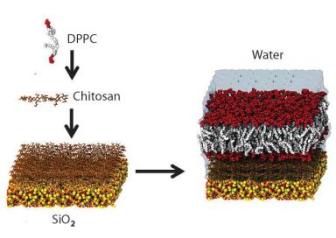Synthetic membranes are used in a wide range of applications such as determining toxicity in the environment and identifying food contaminants and deadly diseases in the body. A research team from Chile has now created a new method of producing ultra-thin membranes by vaporizing off-the-shelf chemicals over silicon surfaces.
 Organic and inorganic materials grouped together to bridge the gap between biology and physics. Credit: S.E.Gutierrez-Maldonado/FCV
Organic and inorganic materials grouped together to bridge the gap between biology and physics. Credit: S.E.Gutierrez-Maldonado/FCV
The process of developing delicate membranes on silicon surfaces marks the creation of bio-silicon interfaces. These interfaces include silicon chips carrying integrated electronic circuits, which are printed with biological "sensor" molecules. María José Retamal, a scientist from Pontificia Universidad Católica de Chile, stated that the goal of the research is to develop a biosensor with an ability to pass on signals via a membrane.
Lipid membranes are the fundamental components of the cell, just like proteins or DNA, and they act as walls separating the neighboring cells. This compartmentalization is key to various physiological processes such as controlling the functions of each organ, regulation of cellular mechanisms, and protecting the DNA of an organism.
Similarly, synthetic membranes that imitate lipid membranes in the body are capable of accommodating membrane proteins which are used in various biosensing applications. Hence, these membranes play a vital role in biological research.
The research team developed the first-of-its-kind synthetic membrane on a silicon support without mixing liquid solvents. Silicon is selected for this work owing to its special characteristics such as chemically controllable hydrophobicity, wide availability, and inexpensiveness. Following mixing of solvents, the team allowed vaporization of chitosan over silicon.
Chitosan is a chemical substance obtained from a sugar molecule, chitin. In the end, they vaporized dipalmitoylphosphatidylcholine – a phospholipid molecule over the chitosan-covered silicon base to form a bilayer.
Spectroscopic results proved the stability of these synthetic membranes over a wide temperature range. Retamal concluded that additional work is required to define the signal transmission mechanism and the process of detecting electric signals in the underlying circuit.